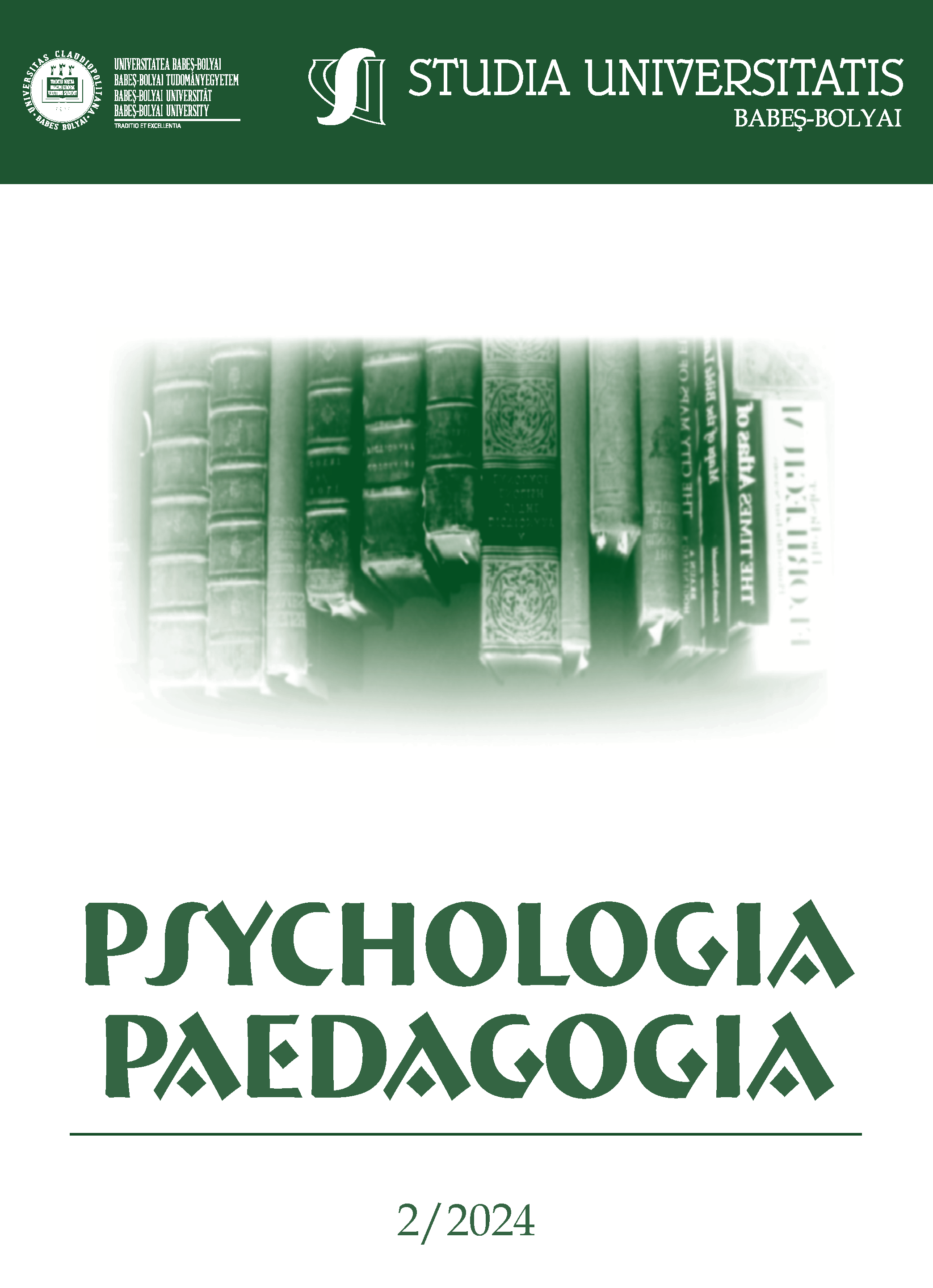Beliefs about Pedophilia and the Attribution of Punishment for Child Sexual Abusers
DOI:
https://doi.org/10.24193/subbpsyped.2024.2.01Keywords:
pedophilia, sexual abuse against children, stigmatization, sexual offense against children, society’s perception of people with pedophiliaAbstract
Pedophilia is a mental illness which may or may not lead to sexual abuse against children. However, when thinking about people with pedophilic sexual interests, people often consider them abusers (even if they did not act against children and did not commit any offense). This is a pilot study aimed to explore the attitudes and perception of people with pedophilic sexual interests in Romania, based on a questionnaire that was distributed on social media (Facebook), having 1077 respondents. The questions concerned the perception of people who sexually abused children and people with pedophilia who did not abused children. The majority of participants in the study believe that people with pedophilia do not have control over their actions, even if they are perceived as ill or criminals. The results of this study have shown that chemical castration is the most preferred punishment for persons who sexually abuse children. Regarding the danger of people with pedophilia, all the respondents believed that it did not matter whether they were just suffering from an illness or if they committed and offence, they were all very dangerous. Regarding the recidivism rate, the majority of the respondents believed that the percentage is between 80-100%. Roughly half of the respondents who have children perceived 100% chances for the people with pedophilia to relapse. Further consideration and implications were discussed.
References
American Psychiatric Association (2013). Diagnostic and statistical manual of mental disorders (5th ed.) Washington, DC.
Babchishin, K., Hanson, K., & VanZuylen H. (2013). Online ChiPornography Offenders are Different: A Meta-analysis of the Characteristics of Online and Offline Sex Offenders Against Children. Archives of Sexual Behavior. doi: 10.1007/s10508-014-0270-x.
Cantor, J. M., & McPhail, I. V. (2016). Non-offending pedophiles. Current Sexual Health Reports, 8(3), 121-128.Clark, C., & Mezey, G. (1997). Elderly sex offenders against children: A descriptive study of child sex abusers over the age of 65. Journal of Forensic Psychiatry, 8(2), 357-369.
Dombert, B., Schmidt, A. F., Banse, R., Briken, P., Hoyer, J., Neutze, J., & Osterheider, M. (2016). How common is men's self-reported sexual interest in prepubescent children? The Journal of Sex Research, 53(2), 214-223.
Eher, R., Rettenberger, M., & Turner, D. (2019). The prevalence of mental disorders in incarcerated contact sexual offenders. Acta Psychiatrica Scandinavica, 139(6), 572-581.
Hanson, R. K., Broom, I., & Stephenson, M. (2004). Evaluating community sex offender treatment programs: A 12-Year follow-up of 724 offenders. Canadian Journal of Behavioural Science, 36(2), 87.
Harris, A. J. R., & Hanson, R. K. (2004). Sex offender recidivism: A simple question (No. 2004-03). Ottawa: Public Safety and Emergency Preparedness Canada.
Imhoff, R. (2015). Punitive attitudes against pedophiles or persons with sexual interest in children: Does the label matter? Archives of Sexual Behavior, 44(1), 35-44.
Imhoff, R., &Jahnke, S. (2018). Determinants of punitive attitudes toward people with pedophilia: Dissecting effects of the label and intentionality ascriptions. Archives of Sexual Behavior, 47(2), 353-361.
Jahnke S., Imhoff, R., & Hoyer, J. (2014). Stigmatization of People with Pedophilia: Two Comparative Surveys. Archives of Sexual Behavior. https://doi.org:10.1007/s10508-014-0312-4.
Jahnke S., Schmidt, A. F., Geradt, M., & Hoyer, J. (2015). Stigma-related stress and its correlates among men with pedophilic sexual interests. Archives of Sexual Behavior. https://doi.org:10.1007/s10508-015-0503-7.
Jahnke, S. (2018). Emotions and cognitions associated with the stigma of non-offending pedophilia: A vignette experiment. Archives of sexual behavior, 47(2), 363-373.
Joyal, C. C., & Carpentier, J. (2017). The prevalence of paraphilic interests and behaviors in the general population: A provincial survey. The Journal of Sex Research, 54(2), 161-171.
Katz-Schiavone, S., Levenson, J. S., & Ackerman, A. R. (2008). Myths and facts about sexual violence: public perceptions and implications for prevention. Journal of Criminal Justice and Popular Culture, 15(3), 291–311.
Kahneman, D., & Frederick, S. (2005). A model of heuristic judgment. In K. J. Holyoak, & R.G. Morrison (Eds.), The Cambridge Handbook of Thinking and Reasoning (pp. 267-293). Cambridge, UK: Cambridge University Press.
Lasher M., & Stinson J. (2017). Adults with pedophilic interests in the United States: Current practices and suggestions for future policy and research. Archives of Sexual Behavior. https://doi.org:10.1007/s10508-016-0822-3.
Levenson, J., Brannon, Y., Fortney, T., & Baker, J. (2007). Public perceptions about sex offenders and community protection policies. Analyses of Social Issues and Public Policy, 7(1), 137-161.
Mancini, C., & Mears, D. P. (2010). To execute or not to execute? Examining public support for capital punishment of sex offenders. Journal of Criminal Justice, 38(5), 959968. https://doi.org/10.1016/j.jcrimjus.2010.06.013.
Moulden, H. M., Firestone, P., Kingston, D., & Bradford, J. (2009). Recidivism in pedophiles: An investigation using different diagnostic methods. The Journal of Forensic Psychiatry & Psychology, 20(5), 680-701.
Richards, K. (2018). Born this way? A qualitative examination of public perceptions of the causes of pedophilia and sexual offending against children. Deviant Behavior, 39(7), 835-851.
Rettenberger, M., Briken, P., Turner, D., & Eher, R. (2015). Sexual offender recidivism among a population-based prison sample. International Journal of Offender Therapy and Comparative Criminology, 59(4), 424-444.
Sanghara, K., & Wilson J., C. (2006). Stereotypes and attitudes about child sexual abusers: A comparison of experienced and inexperienced professionals in sex offender treatment. Legal and Criminological Psychology, 11, 229–244.
Stevenson, M. C., Najdowski, C. J., Salerno, J. M., Wiley, T. R., Bottoms, B. L., &Farnum, K. S. (2015). The influence of a juvenile’s abuse history on support for sex offender registration. Psychology, Public Policy, and Law, 21(1), 35.
West, D. (2000). Paedophilia: plague or panic? The Journal of Forensic Psychiatry, 11(3), 511-531.https://doi.org:10.1080/09585180010002669
National Administration of Penitentiaries. Retrieved from http://www.anp.gov.ro/.
Downloads
Published
How to Cite
Issue
Section
License
Copyright (c) 2024 Studia Universitatis Babeș-Bolyai Psychologia-Paedagogia

This work is licensed under a Creative Commons Attribution-NonCommercial-NoDerivatives 4.0 International License.


